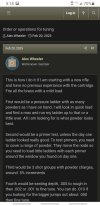So you dont think changing primers affects how a load shoots just like adjusting your charge rate? Ever chronographed different primers with the exact same load, if you have you will see that the velocity goes up and down just like adjusting your powder charge.Changing primers and powder wouldn't be tuning because they are the base components for the load.
Theres a " tuning" list Alex posted on LRO how he starts tuning a load and I do pretty much exactly the same way, ive been fortunate to shoot with one of his shooters who tests more than anybody I know out there and Alex has said the same thing. He has helped me " tune " up my loads these last few years by watching, listening and asking Questions.
I originally made this post to show that people who obsese with single digit E.S. need to understand its not the end all be all especially for 99% percent of us me included, I have no interest at anything past 1,000 and in all reality not quite even that far hunting.
The one on the right is the first paragraph


